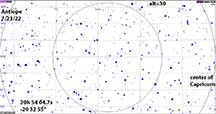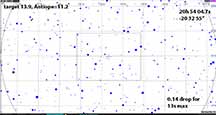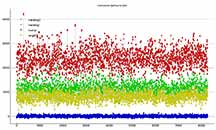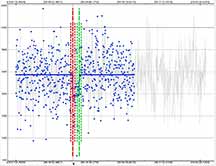


Orientation on the sky as seen from the Earth plane. The centerline should see a narrow miss between both components. The actual northern and southern limits are wider than the OW path at left.

This event happens during my Astro 25 field class at Stanislaus River. It should be do-able if we have cloud-free skies. The 11.58 magnitude combined image will drop to 11.72 for up to 12 seconds. The projected sky plane of the binary pair of asteroids says that we should comfortably get the southern component, and the actual southern limit will be well below the nominal OW southern limit shown. The duration will probably be roughly 8 sec for us. I'd suggest an integration of 8x. Altitude is 31 degrees up, near due south, and well described as being in the geometric center of the "smile" of Capricorn.
The event will drop only 0.14 magnitude and be invisible to the eye, but should be do-able with good data and software. might have to defocus a bit to insure no saturation!
Unfortunately Hwy 4 extends parallel to the path, so it would be rather difficult to send either Kirk or I to somewhere north or south of camp perpendicular to the path. Perhaps just up to Hwy 4 to nominally be somewhere different and not waste much time? Or, just stay both of us in camp and re-inforce our timings.
 |
 |
 |
Orientation on the sky as seen from the Earth plane. The centerline should see a narrow miss between both components. The actual northern and southern limits are wider than the OW path at left. |
 |
Kirk and I both got successful recordings of this low-amplitude event. In the end, given the problem with the track direction making it very difficult in this part of the Sierra to separate ourselves, and at 3am too... we both set up just ~20 feet from each other, with Kirk SW of me. The orientation of the southern component does not give us a strong clue of what duration to expect, except that it would be unlikely to be larger than the 13s expected maximum duration. Jerry Bardecker got a success from about 20km closer to the centerline, with a 12" telescope. His timing errors are still worse than one would hope, as is mine and Kirk's. At least he got a consistent duration result of 8s. My data never got the red bar to the right of the black bar, but it got close. My duration for different attempts was always near 7 or 8 seconds, similar to Jerry's. Kirk's results were mostly getting 14-20 sec durations, which were probably just too high to be realistic. Since we were in the same place, difference must come from differing equipment, settings, or perhaps some drifting wisp of smoke that got into the occultation a second or two different than mine??
We tried hard to use identical observational settings, to avoid saturation but still maintain good time resolution. The target star was magnitude 13.9. My conviction is that one should set the integration so as to answer the question: "What integration would be necessary to see the target star completely disappear with good confidence?" Rather than setting it to the combined brightness, which would lead one to set the integration too short and have the dip lost in the noise. I decided 8X was a good compromise, as we also wanted to avoid saturation. So, we both did two things. I set my Gain to 40 (instead of the usual maximum of 41), and Kirk was a bit less. We also de-focused a bit, but not too much because there was a second 13.9 star not far from the target.
Kirk's reduction attempts in PyMovie and PyOTE almost always ended up with durations much longer than mine or Jerry's and yet his camera is, I believe, less noisy than mine. In particular, he doesn't have the vertical noise column lines that I do. It's not impossible that the true duration was longer than 8s. 10s is quite possible, maybe even 11s, but longer than that seems rather unlikely since the predicted 12s maximum was for a combined 2-component circular mushed-together asteroid, and yet we were looking at just the south component. Kirk and I both used the following settings to achieve a 0-false-positive result and duration of 8-9s. I, like Kirk, tried many combinations of aperture size, static vs snap-to, different tracking stars, using reference star or not, and all my results were worse (failing red bar test) than the setting I settled upon. For Kirk as well, we got the most likely correct and best odds of 0-false-positive, with the settings below. My 0-false-positive test never did get across, but it wasn't that bad, and again - the 0-false-positive I believe, and programmer Bob Anderson believes, is too strict to use as a disqualifier, especially given the other observers.
PyOTE photometry: I used the standard "background subtracted" setting, after failing worse with the "appsum only" setting (ie no sky subtraction), and Kirk's duration then being 13s. So he tried the suggestion which worked on my Erida event of not doing a background subtraction. With a nearby star possibly confusing the background, sometimes it's best to not do a background subtraction, and that did help Kirk's results and is what gave his 0-false-positive and more reasonable duration, of 9.3s. It didn't help mine to do appsum, so I used standard background subtraction.
Aperture size: We both set it at 21 pixels in PyMovie. (my recommendation and consistent with my choice), rather than the usual 31 pixels. Reason: the aperture box size determines where the "background" (sky) brightness is sampled from, and we didn't want to include confusing stars, even though there's built-in software to avoid other stars within that aperture. 11 pixel was tried by both Kirk and I, but this seemed clearly too small for our defocused (and also mediocre seeing that night) situation, so that too much of the box was filled with starlight and likely not enough ability to find true skylight.
Integration: This success suggestion came from Ted Swift, who recommended that to get better S/N given our point to point significant up/down/up/down pattern near the occultation, to smooth an additional level. So rather than telling PyOTE to combine using the 8x setting appropriate, we told PyOTE to combine 8 points (8 fields, as if 16x setting) into a single integration. This seemed to give the most consistent results between our two stations, and also with Jerry Bardecker's. So, for future reference, the advice is to use the camera setting, regardless of how you may modify the integration of points manually inside PyOTE. IOTA form's "exposure integration" means exposure, not subsequent combining of points in PyOTE, to be clear about it.
PyMovie mask threshold, usually kept at the default of 2-sigma, we moved to 1-sigma to further guard against keeping the light of a conflicting neighbor. Also we set the default box size to 6.8 pixels although that decision looks moot - the bright target and tracking stars were never tempted to use the default.
|
PyMovie's composite light curves. |
My PyMovie screen. The center box is Antiope. We used 2 tracking stars to guard against field rotation. |
The target light curve in PyMovie, raw. The vertical bar at the predicted occultation and actual. |
My PyOTE solution light curve. I always try to screen-capture also with the timings on the same image, to minimize images and making my report. |
My light curve still didn't quite satisfy the "zero chance of a false positive test", but for such a shallow drop and poor seeing, it's not that surprising |
D: 9:49:23.84 UT +- 2.45s (2-sigma)
R: 9:49:32.11 UT +- 2.45s (2-sigma)
Duration: 8.27s
Kirk's solution is consistent with mine, within our error bars...
John Moore attempted more reductions, but were not an improvement on mine, so I've sent in my own reductions. Report sent in 8/2/22 for Nolthenius.
 |
 |
 |
 |
 |
 |
magDrop: 0.140 +/- 0.052 (0.95 ci) snr: 1.01 D time: [09:49:21.9810] D: 0.6800 containment intervals: {+/- 0.7798} seconds D: 0.9500 containment intervals: {+/- 2.9401} seconds D: 0.9973 containment intervals: {+/- 7.2956} seconds R time: [09:49:31.3235] R: 0.6800 containment intervals: {+/- 0.7798} seconds R: 0.9500 containment intervals: {+/- 2.9401} seconds R: 0.9973 containment intervals: {+/- 7.2956} seconds Duration (R - D): 9.3425 seconds Duration: 0.6800 containment intervals: {+/- 1.3993} seconds Duration: 0.9500 containment intervals: {+/- 4.1253} seconds Duration: 0.9973 containment intervals: {+/- 8.8464} seconds